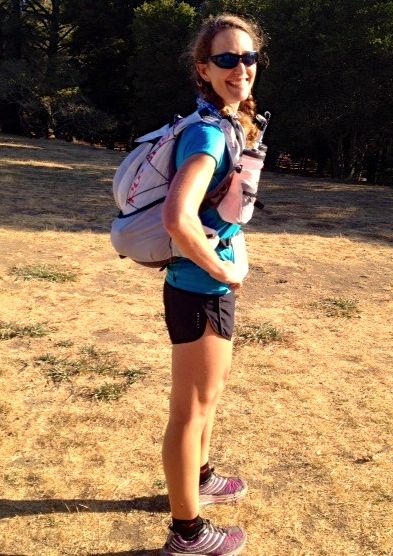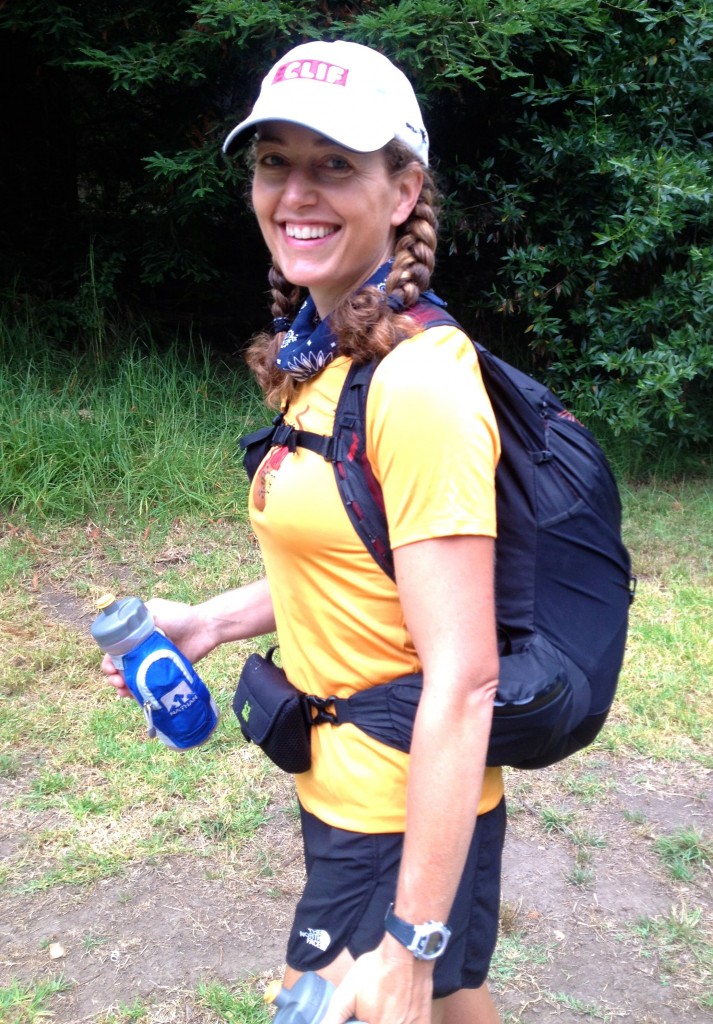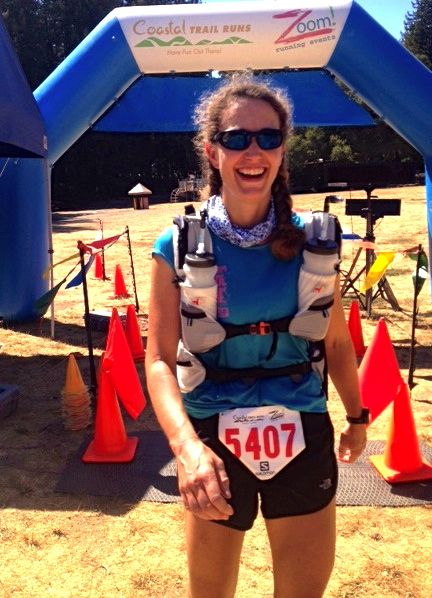Yesterday on my trail run, one runner wondered if I was a Marine and another asked, in all seriousness, if I eat dog food.
I was running the Coastal Trail Runs 50K in Huddart Park near Woodside, wearing my RaidLight Ultralight Olmo 20Lpack filled with 21 pounds of weight. It was my first significant pack training run for the Grand to Grand Ultra, which is a mere six weeks away. (The Grand to Grand is 170 miles long over six stages, self-supported, meaning each participant has to carry a sleeping bag, enough food for a week and other gear.)
I’m going to try to get my pack weight under 20 pounds by making the most efficient, lightweight food and gear choices possible—but when I did the event in 2012, my pack weighed 21 pounds on Day One, so I wanted to practice with that much weight.
I stuffed the pack with my sleeping bag and Ziplock bags full of dog kibble and kitty litter to add bulk and heft. The dead weight felt much heavier than, say, a 20-pound child riding piggyback. It felt like a 5-gallon bucket of cement hanging from my shoulders.
Not surprisingly, the pack slowed my pace significantly. My goal for the day was to run steadily and patiently and finish, and along the way, get used to the pack.
A few miles after the start, I found myself between two women running a conservative pace. The one in front asked me why I had such a big, full pack, so I explained what I was training for.
“I thought you might be a Marine or something!” she said.
“No—but thanks,” I said, taking it as a compliment.
“Are you going to cook a big meal afterward with all the stuff inside?” the woman behind me asked.
“No, you wouldn’t want to eat what’s in there,” I said and explained about the bags of dog kibble and kitty litter.
I could tell they were perplexed, so I explained further, “The kitty litter is just to add weight.” For some reason, I only mentioned the kitty litter.
“So do you eat the dog food?” the woman behind me asked.
I burst out laughing and assured her that the dog food was only for weight, too.
“Well, you know, you never know, because ultra runners do pretty extreme things,” she said.
They both seemed impressed by my pack training, but I wanted to explain that actually, it’s not that impressive. I am playing catch-up on my training, and if I can’t handle an extremely slow 50K with the pack on this relatively easy course, then I’m headed for a DNF at the G2G. I ran very low mileage during the past month while we traveled, and I’m only now starting to get used to the pack and get my fitness to where it needs to be.
This pack is quite different from the Inov-8 Race Elite 25L pack I used for the Grand to Grand in 2012. The Inov-8 did not have water bottle holders on the shoulder straps, and this year I want to keep my hands free rather than using hand-held bottles as I did in 2012. (A hydration bladder is not a good option because it is so difficult to fit it into a stuffed pack and then to refill it.) For whatever reason, I used to like hand-held bottles and thought it was good to transfer some of the weight to my hands and arms; but now, holding bottles bothers me. Additionally, I learned from the Grand to Grand in 2012, it’s best to keep my hands free because there are spots on the course where we need to use our hands to climb.
Unfortunately, the RaidLight pack is not anatomically designed of women. I found it difficult to get the bottles to sit comfortably to the side of my not-very-large breasts; the water bottles either smashed my boobs together or bounced on top of them.
There is an upside to this smashed-boobs situation, however: I realized that I can wear a lighter-weight, less supportive bra since they’re not bouncing around anyway. I wore a bra at yesterday’s 50K made of a very thin layer of lycra and narrow straps, and it worked fine. The last time I did the G2G, I wore a regular thick, heavy-duty sports bra, which I would rinse out at day’s end (along with my other clothing) to try to clean off the sweat. While my shorts and shirt would dry by morning, the thicker fabric of the bra always stayed damp, and I hated the sensation of putting on a damp, smelly bra. That’s one problem I look forward to eliminating this time (the dampness, that is—not the smell, unfortunately!).
I also noticed a few “hot spots” with chafing on my back, but that’s to be expected. Next time, I’ll cover these areas with KT Tape. Overall, I think I like this new pack more than my old one, because it’s less bouncy and the straps don’t cut into my neck the way the Inov-8’s did, and it has better pocket design.
The RaidLight pack comes with an optional 4L front pack, which I bought, but I realized right away that there’s no way I can tolerate it—it’s too annoying, like a fanny pack turned forward on the belly, and involves too many straps that are a pain to adjust. I’m going to try my best to fit all my stuff into the backpack without needing the front pack. If I simply can’t make everything fit, then I will strap my sleeping bag to the bottom of the pack (at least for the first day or two, until the reduced food supply in the pack frees up enough space to fit the sleeping bag inside).
I also plan to buy and use a little Amphipod pouchfor the waist strap (as pictured on the photo above of my old pack). These small pouches are useful to carry the race course map and punchcard that we need punched at checkpoints.
The 50K ended up taking me nearly 6 hours, 40 minutes—about an hour and a half longer than a 50K on this course would normally take me. I was just happy to get in a solid, mostly problem-free long run with the pack.
I’ll do more pack training in the weeks ahead, but I need to be careful because I can tell it could trigger injury. My knees and feet are sore from absorbing 20+ extra pounds of weight with each step. I think I’ll do a pack run just once a week, but try to wear my pack often throughout the day when I’m just walking around, like when I take the dog to the park, so that my shoulders and core get used to the sensation.
And if anyone asks me what’s in it or why I’m wearing it, I’ll probably avoid the details like the bags of kitty littler. It’s much simpler and less freakish to say, “Goin’ camping!”




I love that ultra runners eating dog food seemed plausible! I also think it’s funny that I took that pack picture at the 50K and the one from two years ago (at least I think that’s the one I took at ITR Skirt n Dirt when you were first trying out the pack).
And I’m not going to mention that your pack-infested time for this 50K would be a great normal PR for me!